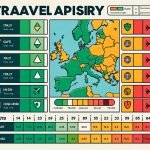Italy is currently under a Level 4 travel advisory, indicating that it is not safe for individuals to travel to this country. This advisory has been put in place due to the ongoing situation in Italy, which poses significant risks and dangers for travelers. It is crucial for anyone considering or planning travel to understand the implications of this Level 4 advisory and take necessary precautions.
A Level 4 Travel Advisory signifies the highest level of caution issued by governmental authorities regarding travel to a particular destination. In the case of Italy, this advisory warns against all non-essential travel to the country due to the severity of the current situation. This means that individuals are strongly advised against traveling to Italy unless it is absolutely necessary.
Travel advisories are essential tools in keeping travelers informed and aware of potential risks and dangers in specific destinations. They serve as guidance from governments or international organizations based on various factors such as political unrest, natural disasters, public health concerns, or security threats. By following these advisories, travelers can make informed decisions regarding their safety and wellbeing.
The current Level 4 advisory for Italy is a result of the ongoing COVID-19 pandemic. Italy was severely impacted by the virus, leading to a high number of cases and fatalities.
The Italian government has implemented strict measures to control the spread of the virus, including lockdowns, travel restrictions, and mandatory quarantine protocols. These measures have contributed to the Level 4 advisory as they have significantly disrupted daily life and pose substantial risks for travelers visiting or transiting through Italy.
History of Travel Advisories in Italy
Italy has experienced a history of travel advisories, with various factors contributing to their issuance. These advisories have had significant impacts on the country’s tourism industry and local businesses. In this section, we will provide an overview of the past travel advisories issued for Italy, analyze the factors that led to their issuance, and discuss how Italy has managed these advisories in the past.
Past Travel Advisories
Italy has seen several travel advisories over the years due to various reasons such as political instability, terrorist threats, natural disasters, and public health emergencies. For instance, in 2015, a Level 2 Travel Advisory was issued due to incidents of terrorism in Europe. Similarly, in 2016, a Level 2 Advisory was issued specifically for Rome and Milan due to potential risks associated with terrorism.
Another notable advisory was issued in 2020 when Italy became one of the epicenters of the global COVID-19 pandemic. The Level 4 Travel Advisory was implemented due to widespread transmission of the virus in the country. This advisory discouraged all non-essential travel to Italy and highlighted the risks associated with exposure to COVID-19.
Factors Contributing to Previous Advisories
Several factors have contributed to previous travel advisories for Italy. Political instability and terrorist threats have been recurring concerns that prompted advisory issuances. Additionally, Italy’s geographical location as a Mediterranean country makes it susceptible to risks associated with migration flows from nearby conflict zones.
Italy’s position as a popular tourist destination also plays a role in travel advisories. Large numbers of tourists visiting historic sites and major cities can present opportunities for criminal activities such as pickpocketing or scams targeting unsuspecting travelers.
Management of Past Advisories
In response to previous travel advisories, Italian authorities have taken proactive measures to ensure traveler safety and mitigate risks. Law enforcement agencies have increased security measures in prominent tourist areas and implemented strategic monitoring to prevent potential threats.
Furthermore, Italy has placed emphasis on public awareness campaigns to promote safety among tourists. These campaigns include providing information on common scams, advice on personal safety, and guidelines for reporting any suspicious activities. The collaboration between local law enforcement, tourism agencies, and the public has been instrumental in managing previous advisories effectively.
It is essential to understand the history of travel advisories in Italy to gain insights into their impact and how the country has responded in the past. This knowledge can help both travelers and local stakeholders navigate the current Level 4 Travel Advisory more effectively and ensure the safety of all parties involved.
Detailed Overview of Level 4 Travel Advisory for Italy
Specific Reasons for the Level 4 Advisory
The Level 4 Travel Advisory issued for Italy is a result of several specific reasons that have raised significant concerns for travelers. One of the main factors contributing to this advisory is the high number of COVID-19 cases reported in the country.
Italy has been struggling to contain the spread of the virus, with a significant increase in cases and deaths. The overcrowding of hospitals, shortage of medical resources, and overwhelmed healthcare system have all contributed to the decision to issue a Level 4 advisory.
Another reason for the Level 4 Travel Advisory is the presence of organized crime activities in certain areas of Italy. These criminal organizations have been known to target tourists, leading to safety concerns for visitors. The possibility of pickpocketing, scams, and even more serious crimes poses a real threat to travelers.
Risks and Dangers Highlighted by the Advisory
The Level 4 Travel Advisory highlights various risks and dangers that travelers may face in Italy. The primary concern mentioned in the advisory is the risk of contracting COVID-19 due to widespread community transmission. The Italian healthcare system is under strain, making it difficult for both locals and tourists to receive adequate medical care if required. This poses a considerable health risk for travelers who may experience severe symptoms or complications from the virus.
Additionally, there are warnings about potential terrorist attacks targeting crowded places such as tourist attractions or transportation hubs. Tourists are advised to remain vigilant and take necessary precautions such as avoiding large gatherings or crowded areas.
Areas in Italy Affected by the Advisory
The Level 4 Travel Advisory encompasses all regions throughout Italy due to its widespread COVID-19 impact and reported criminal activities. However, there are certain areas that are highlighted as higher-risk zones requiring extra caution from travelers. These include densely populated cities like Rome, Florence, Milan, Naples, and Venice. Tourist hotspots, popular attractions, and public transportation systems in these areas have been identified as potential high-risk locations for both health and safety concerns.
It is important to note that the Level 4 advisory may vary within different regions of Italy, with some areas experiencing more severe conditions than others. Travelers are advised to monitor local updates and consult with their embassy or consulate for specific guidance based on their intended destinations within Italy.
Safety Measures and Precautions to Follow
As a Level 4 Travel Advisory for Italy is in place, it is crucial for travelers to prioritize their safety and take necessary precautions. Here are some important safety measures that should be followed while visiting Italy:
- Stay informed and monitor local updates: It is essential to regularly check for any updates or changes to the travel advisory. This can be done by subscribing to email alerts from government travel websites or following official social media accounts of relevant authorities. Staying informed about the current situation will enable travelers to make well-informed decisions regarding their travel plans.
- Follow health and hygiene guidelines: In order to reduce the risk of contracting or spreading COVID-19 or other infectious diseases, it is important to follow recommended health and hygiene practices. These include wearing masks in public places, practicing social distancing, frequently washing hands with soap and water, using hand sanitizers when necessary, and avoiding touching one’s face.
- Avoid high-risk areas: The Level 4 advisory will specify the areas that are considered high-risk due to various factors such as security threats, natural disasters, or health emergencies. Travelers should strictly avoid these areas until the advisory is lifted or until authorities deem them safe again.
- Maintain personal safety: In addition to health-related precautions, travelers should also take steps to ensure their personal safety. This includes being aware of one’s surroundings, avoiding risky behaviors or situations, and keeping valuable belongings secure.
- Have a contingency plan: It is advisable for travelers to have a contingency plan in case of emergencies or unexpected situations. This may involve having access to emergency contact numbers (such as embassy contacts), purchasing comprehensive travel insurance that covers various scenarios, and informing trusted family members or friends about one’s itinerary.
Impact on Tourism and Travel Industry in Italy
The Level 4 Travel Advisory for Italy has had a significant impact on the country’s tourism and travel industry. With the advisory highlighting the risks and dangers present in Italy, travelers have been hesitant to visit, resulting in a decline in tourism. This decline has had severe economic implications for local businesses and the hospitality industry.
The Level 4 advisory has led to a significant decrease in tourist arrivals, affecting hotels, restaurants, tour operators, and other businesses dependent on tourism revenue. Many establishments have reported a sharp drop in bookings and cancellations of reservations. The lack of tourist activity has resulted in financial struggles for businesses, causing losses in revenue and potential job cuts.
To mitigate the impact of the advisory, the Italian government has taken several steps. They have implemented measures to support affected businesses financially through grants, tax breaks, and low-interest loans. Additionally, they have launched campaigns to promote domestic tourism and attract local travelers to fill the void left by international tourists.
During the Level 4 advisory period, initiatives have been introduced to ensure safe tourism practices. These initiatives include increased hygiene protocols at tourist attractions, accommodation facilities, and restaurants. Tour operators have also implemented strict safety measures such as reduced group sizes, mandatory mask-wearing, and enhanced sanitization processes. By prioritizing visitor safety, these measures aim to instill confidence among travelers willing to visit Italy despite the travel advisory.
Despite these efforts by both the government and industry players, it is challenging to predict when exactly the Level 4 advisory for Italy will be lifted. It depends on various factors such as control over COVID-19 transmission rates within the country and advancements in vaccination efforts globally. However, with ongoing vaccinations and effective containment strategies being implemented worldwide, there is hope that travel restrictions will ease in due course.
Overall, while the Level 4 Travel Advisory for Italy has caused significant challenges for the tourism and travel industry, there are signs of recovery as cautious optimism grows within the sector. By adapting to the new normal and prioritizing safety measures, Italy is positioning itself for a strong comeback when travel restrictions are eventually lifted.
Traveler Testimonials and Experiences during Level 4 Advisory
Italy’s Level 4 Travel Advisory has significantly impacted travelers visiting the country. Many individuals have shared their experiences and testimonials during this unprecedented time, shedding light on the challenges and triumphs faced while navigating the advisory. These real-life stories offer valuable insights for others who may find themselves in a similar situation.
Travelers who have successfully navigated the Level 4 advisory emphasize the importance of staying informed and following safety measures. They stress the need to closely monitor local updates, including any changes or developments in restrictions or guidelines. By staying up to date with reliable sources of information, these individuals were able to make informed decisions about their travel plans and adapt quickly to any new regulations.
Positive experiences during the Level 4 advisory often involve embracing alternative travel options, such as exploring lesser-known regions or smaller towns in Italy that may not be heavily affected by the advisory. Many travelers found solace in these hidden gems, enjoying a more authentic and less crowded experience while still adhering to safety precautions.
On the other hand, cautionary tales serve as reminders of the risks involved in traveling during a Level 4 advisory. Some individuals faced difficulties such as sudden quarantine measures, limited transportation options, or language barriers when seeking assistance. These accounts highlight the importance of being prepared for unforeseen circumstances and having contingency plans in place.
| Positive Experiences | Cautions and Difficulties |
|---|---|
| Exploring lesser-known regions | Sudden quarantine measures |
| Authentic and uncrowded travel experiences | Limited transportation options |
| Adapting quickly to changing regulations | Language barriers when seeking assistance |
Updates and Changes to Level 4 Advisory
Italy, like many other countries, is constantly evolving in its response to the COVID-19 pandemic. As a result, travel advisories and guidelines are subject to updates and changes. It is important for travelers to stay informed about any developments or improvements in the situation before planning their trip to Italy.
The Level 4 Travel Advisory for Italy may undergo adjustments based on emerging data and the assessment of risk factors. These updates are crucial in providing travelers with the most accurate and up-to-date information regarding travel safety and risks associated with visiting Italy.
It is recommended to regularly check official government websites, such as the U.S. Department of State or equivalent authority from your country of origin, for any updated information on travel advisories and restrictions for Italy. In addition, monitoring reliable news sources can also help provide insights into the current situation in Italy.
As part of staying informed, it is essential to pay attention to any changes or adjustments made to entry requirements, quarantine regulations, testing protocols, and local restrictions imposed by Italian authorities. Keep in mind that travel advisories can change rapidly depending on the evolving circumstances surrounding the pandemic.
Remaining flexible and adaptable with travel plans while keeping a close eye on updates will ensure that travelers can make informed decisions about whether or not to visit Italy during this Level 4 advisory period. Taking precautions and following safety measures recommended by health officials will further contribute to minimizing risks associated with traveling during these uncertain times.
| Key Points | Updates |
|---|---|
| Travel Advisory Level | Level 4 |
| Risks Highlighted | Data collected from assessments of risk factors. |
| Affected Areas | Italy |
| Duration of Advisory | No specific timeline mentioned, subject to change based on emerging data. |
Conclusion and Future Expectations
In conclusion, the Level 4 Travel Advisory for Italy serves as a crucial reminder of the importance of staying informed and taking precautions while traveling. This advisory highlights the significant risks and dangers present in certain areas of Italy and emphasizes the need for travelers to prioritize their safety. It is essential to adhere to the comprehensive list of safety measures recommended by authorities and to monitor local updates closely.
The impact of the Level 4 advisory on tourism and the travel industry in Italy cannot be understated. Local businesses and the hospitality industry are facing significant economic implications as tourist numbers dwindle. However, despite these challenges, the Italian government has taken steps to mitigate the impact by implementing initiatives that promote safe tourism during this advisory period. These efforts aim to reassure visitors and provide a sense of security amidst uncertain times.
Looking ahead, it is difficult to predict when the Level 4 advisory might be lifted. As with any situation involving public health and safety, caution must prevail. Speculation suggests that a decline in COVID-19 cases and an increase in vaccination rates will play a significant role in determining when travel restrictions may ease. Until then, travelers should prepare themselves for potential future advisories and remain flexible with their travel plans.
In closing, it is crucial for individuals considering traveling to Italy or any other destination to understand the significance of travel advisories like Level 4. By being aware of potential risks, following recommended safety measures, and prioritizing personal safety, travelers can help mitigate any potential dangers they may encounter during their journeys.
While it may take time before international travel returns to its pre-pandemic state, by staying well-informed and remaining vigilant, we can look forward to a brighter future where travel opportunities abound once again.
Frequently Asked Questions
What is the current travel advisory level for Italy?
The current travel advisory level for Italy is Level 3: Reconsider Travel. This means that the U.S. Department of State has issued a warning advising travelers to reconsider their plans before visiting the country due to certain safety and security concerns.
While not explicitly prohibiting travel, this advisory suggests exercising caution and evaluating the risks involved before making any arrangements to visit Italy.
What are Level 4 travel restrictions?
Level 4 travel restrictions are the most serious level of travel advisory issued by the U.S. Department of State. When a country is designated as Level 4, it means that the department strongly advises against all travel to that destination due to significant safety or security risks.
This could be due to factors such as ongoing conflict, terrorism threats, or high crime rates. Level 4 restrictions indicate that there may be a substantial threat to the safety and well-being of American travelers in that particular country.
What does an American need to travel to Italy?
To travel to Italy as an American citizen, several requirements must be met. First and foremost, a valid passport is essential for entry into Italy; it should remain valid for at least three months beyond your planned departure date from Italy.
Additionally, U.S. citizens are not required to obtain a visa for stays in Italy lasting up to 90 days within any 180-day period, but longer stays or specific purposes (such as studying or working) may necessitate additional permits or visas.

I’m a passionate traveler, writer, and Italophile. My fascination with Italy’s history, art, and culture has led me on countless adventures across the Italian landscape. Through “I Live Italy,” I share my love for this extraordinary country and aims to inspire others to explore its boundless beauty.





